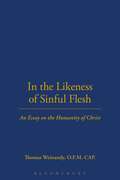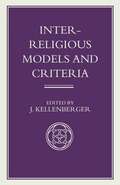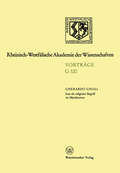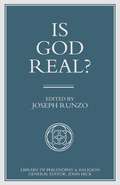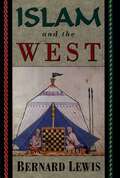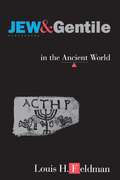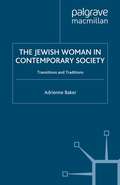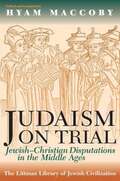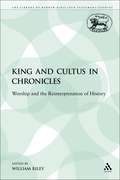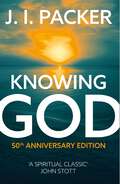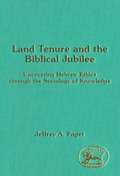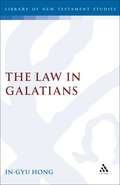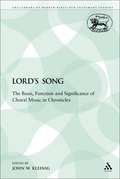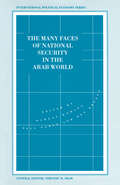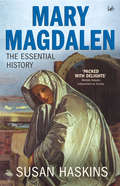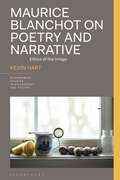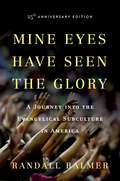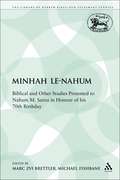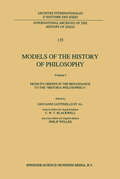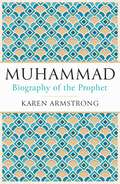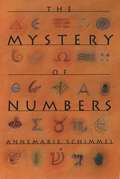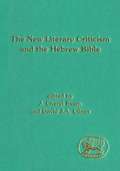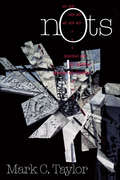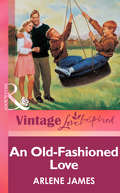- Table View
- List View
In the Likeness of Sinful Flesh: An Essay on the Humanity of Christ
by Thomas WeinandyForeword by Colin Gunton.Draws upon both the Catholic and the Protestant theological traditions to explore the humanity of Jesus.
Inter-Religious Models and Criteria
by J. KellenbergerThis book is a collection of papers presented and discussed at the 1992 Claremont Conference. Its contributing authors come from various disciplines that share a concern with models and criteria for inter-religious understanding, including religious studies, philosophy of religion, theology, comparative studies, and feminist philosophy.
Iran als religiöser Begriff im Mazdaismus: 355. Sitzung am 18. März 1992 in Düsseldorf (Rheinisch-Westfälische Akademie der Wissenschaften #320)
by Gherardo GnoliIslam: Area 1 Religion And Ethics Through Christianity, Area 2 Religion, Peace And Conflict Through Islam (Bullet Guides)
by Victor W WattonOpen this book and you will Discover Islamic worship Learn about Muhammed Explore the Qur'an Understand contemporary issues
Islam and the West (The\cambridge History Of Islam Ser.)
by Bernard LewisHailed in The New York Times Book Review as "the doyen of Middle Eastern studies," Bernard Lewis has been for half a century one of the West's foremost scholars of Islamic history and culture, the author of over two dozen books, most notably The Arabs in History, The Emergence of Modern Turkey, The Political Language of Islam, and The Muslim Discovery of Europe. Eminent French historian Robert Mantran has written of Lewis's work: "How could one resist being attracted to the books of an author who opens for you the doors of an unknown or misunderstood universe, who leads you within to its innermost domains: religion, ways of thinking, conceptions of power, culture--an author who upsets notions too often fixed, fallacious, or partisan." In Islam and the West, Bernard Lewis brings together in one volume eleven essays that indeed open doors to the innermost domains of Islam. Lewis ranges far and wide in these essays. He includes long pieces, such as his capsule history of the interaction--in war and peace, in commerce and culture--between Europe and its Islamic neighbors, and shorter ones, such as his deft study of the Arabic word watan and what its linguistic history reveals about the introduction of the idea of patriotism from the West. Lewis offers a revealing look at Edward Gibbon's portrait of Muhammad in Decline and Fall of the Roman Empire (unlike previous writers, Gibbon saw the rise of Islam not as something separate and isolated, nor as a regrettable aberration from the onward march of the church, but simply as a part of human history); he offers a devastating critique of Edward Said's controversial book, Orientalism; and he gives an account of the impediments to translating from classic Arabic to other languages (the old dictionaries, for one, are packed with scribal errors, misreadings, false analogies, and etymological deductions that pay little attention to the evolution of the language). And he concludes with an astute commentary on the Islamic world today, examining revivalism, fundamentalism, the role of the Shi'a, and the larger question of religious co-existence between Muslims, Christians, and Jews. A matchless guide to the background of Middle East conflicts today, Islam and the West presents the seasoned reflections of an eminent authority on one of the most intriguing and little understood regions in the world.
Jew and Gentile in the Ancient World: Attitudes and Interactions from Alexander to Justinian
by Louis H. FeldmanRelations between Jews and non-Jews in the Hellenistic-Roman period were marked by suspicion and hate, maintain most studies of that topic. But if such conjectures are true, asks Louis Feldman, how did Jews succeed in winning so many adherents, whether full-fledged proselytes or "sympathizers" who adopted one or more Jewish practices? Systematically evaluating attitudes toward Jews from the time of Alexander the Great to the fifth century A.D., Feldman finds that Judaism elicited strongly positive and not merely unfavorable responses from the non-Jewish population. Jews were a vigorous presence in the ancient world, and Judaism was strengthened substantially by the development of the Talmud. Although Jews in the Diaspora were deeply Hellenized, those who remained in Israel were able to resist the cultural inroads of Hellenism and even to initiate intellectual counterattacks. Feldman draws on a wide variety of material, from Philo, Josephus, and other Graeco-Jewish writers through the Apocrypha, the Pseudepigrapha, the Church Councils, Church Fathers, and imperial decrees to Talmudic and Midrashic writings and inscriptions and papyri. What emerges is a rich description of a long era to which conceptions of Jewish history as uninterrupted weakness and suffering do not apply.
The Jewish Woman in Contemporary Society: Transitions and Traditions
by A. BakerAcross the religious/non-religious spectrum, Jewish women have been affected by the women's movement, the impact on some leading to a reassessment of the woman's role in Judaism, with its emphasis on family and home. Conversely, a small but significant minority have withdrawn into the safety of extreme Orthodoxy. In the centre, the majority are seeking a balance between the powerful internalized message of Judaism, extolling marriage and motherhood as woman's primary concern, and a changing perception of themselves.
Judaism on Trial: Jewish-Christian Disputations in the Middle Ages (The Littman Library of Jewish Civilization)
by Hyam MaccobyHyam Maccoby's now classic study focuses on the major Jewish—Christian disputations of medieval Europe: those of Paris (1240), Barcelona (1263), and Tortosa (1413–14). It examines the content of these theological confrontations with a sense of present-day relevance, while also discussing the use made of scriptural proof-texts. Part I provides a general thematic consideration of the three disputations and their social and historical background. Part II is a complete translation of the account of the Barcelona Disputation written by Nahmanides, one of the greatest figures in the history of Jewish learning, and was Jewish spokesman at the disputation. Part III contains Jewish and Christian accounts of the Paris and Tortosa disputations. A new introduction reviews the relevant literature that has been published since the original edition appeared.
King and Cultus in Chronicles: Worship and the Reinterpretation of History (The Library of Hebrew Bible/Old Testament Studies)
by William RileyBy means of a final-form consideration of the Chronicler's narrative, this study focuses attention on Chronicles' portrayal of the interactive relationship between the Jerusalem kings and the Jerusalem cultus. The Chronicler's development of ancient Near Eastern royal and temple ideologies is examined-a development that allowed the monarchical ideologies to be applied to Judah long after kingship had ceased. How the Chronicler's portrayal of the relationship between the kings and the Jerusalem cultus allowed monarchical ideologies to be applied to Judah long after kingship had ceased.
Knowing God: Know The Fullness Of Life With God
by J.I. PackerFor more than 30 years, J. I. Packer's classic book KNOWING GOD has revealed to well over a million readers the wonder, glory and the joy of knowing God. It continues to sell in tens of thousands to Christians around the world.
Land Tenure and the Biblical Jubilee: Uncovering Hebrew Ethics through the Sociology of Knowledge (The Library of Hebrew Bible/Old Testament Studies)
by Jeffrey A. FagerThe biblical jubilee represents one of the most radical programmes for land reform from the ancient Near East, yet it was never practised in ancient Israel. What then is the meaning of this sacred law that was never enforced? This cogently argued book attempts to answer that question by using the tools of sociological analysis. Fager examines three levels of meaning within the jubilee legislation, which was produced by the priestly intellectuals during the period of exile. The actual words of the text carry one meaning and the priests intended a slightly different meaning, but underlying both was a moral world view that guided them. The laws of the biblical jubilee thus enable us to examine the deepest level of the ancient Israelites' understanding of land and justice.
The Law in Galatians (The Library of New Testament Studies #81)
by In-Gyu HongAn investigation of Paul's theology of the law in Galatians, in the light of recent hermeneutical developments. Part I analyses the structure of the letter, the theological perspective of Paul, and the argument and identity of the opponents. On the basis of these three preliminary considerations, Part II treats Paul's view of the law in Galatians. The thrust of the author's argument is that the term nomos refers to the Mosaic law imposed upon Israel at Mount Sinai, and that this law functions on three distinctive levels: as the obligation of the Sinai covenant, as an enslaving power and as an expression of love.
The Lord's Song: The Basis, Function and Significance of Choral Music in Chronicles (The Library of Hebrew Bible/Old Testament Studies)
by John W. KleinigWhy do the books of Chronicles regard the performance of choral music as an integral part of the sacrificial ritual at the temple, despite the lack of sanction for it in the Pentateuch? And why do they stress that it must be synchronized with the presentation of the regular public burnt offering at the temple? These and other questions are answered in this challenging new volume. After an introductory chapter defining the scope of the study as an analysis of the ritual function and theological significance of sacred song, the author examines the divine institution and royal establishment of the Levitical choir in Jerusalem. This is followed by an examination of the components of the Lord's song in terms of its contents, location, times, instruments and performers. A chapter on the function of sacred song as determined by its place within the sacrificial ritual follows, and the fifth chapter deals with its theological significance as the proclamation of the Lord's presence with his people.
The Many Faces of National Security in the Arab World (International Political Economy Series)
by Rex Brynen Bahgat Korany Paul NobleTwo Gulf wars and the continuing Arab-Israeli conflict have highlighted the salience of military factors in the Middle East. This book argues, however, that many of the most serious 'security' challenges to Arab states and societies are rooted not in external military threats but in the imperatives of socio-economic development. Contributors examine the regional security environment; the social and political impact of regional militarization; and underdevelopment as a source of regional insecurity.
Mary Magdalen: Truth and Myth
by Susan HaskinsA dramatic, thought-provoking portrait of one of the most compelling figures in early Christianity which explores two thousand years of history, art, and literature to provide a close-up look at Mary Magdalen and her significance in religious and cultural thought.
Maurice Blanchot on Poetry and Narrative: Ethics of the Image (Bloomsbury Studies in Philosophy and Poetry)
by Kevin HartBlanchot and his writings on three major poets, Mallarmé, Hölderlin, and Char, provide a decisive new point of departure for English language criticism of his philosophical writings on narrative in this study by leading Blanchot scholar, Kevin Hart.Connecting his work to later leading figures of 20th-century French philosophy, including Emmanuel Levinas, Simone Weil, and Jacques Derrida, Hart highlights the importance of Jewish philosophy and political thought to his overall conception of literature. Chapters on community and negation reveal Blanchot's emphasis on the relationship between narrative and politics over the more commonly connected narrative and aesthetics. By fully discussing Blanchot's elusive concept of “the Outside” for the first time, this book progresses scholarly understandings of his entire oeuvre further. This central concept engages Franz Rosenzweig's work on Abrahamic faiths, enabling a reckoning on the role of suffering and literature in the wake of the Shoah, with significant implications for Jewish studies more generally.
Mine Eyes Have Seen the Glory: A Journey Into The Evangelical Subculture In America
by Randall BalmerMinhah Le-Nahum: Biblical and Other Studies Presented to Nahum M. Sarna in Honour of his 70th Birthday (The Library of Hebrew Bible/Old Testament Studies)
by Marc Zvi Brettler Michael FishbaneNahum Sarna's distinctive and original scholarship has taken in a wide range of subject areas from work on Genesis and the Psalms to his Jewish Bible commentary and the English translation of the Ketuvim. At first Assistant Professor of Bible at the Jewish Theological Seminary of America in the 1950s, he was Dora Golding Professor of Bible at Brandeis University from 1965 to his retirement. This collection of 22 essays reflects Professor Sarna's breadth of interests, with contributions from the late Gershon Cohen on the Hebrew Crusade Chronicle and the Ashkenazic tradition; Judah Goldin on Reuben; Moshe Greenberg and Jonas Greenfield on the work of the Jewish Publication Society's Ketuvim translators; and Shemaryahu Talmon on fragments of a Psalms scroll from Masada.
Models of the History of Philosophy: From its Origins in the Renaissance to the ‘Historia Philosophica’ (International Archives of the History of Ideas Archives internationales d'histoire des idées #135)
by C. W. Blackwell Philip WellerModels of the History of Philosophy. From its Origins in the Renaissance to the `Historia philosophica' (a translation of a work published in 1981 in Italian - the bibliography has been updated) gives a comprehensive description of the various forms and approaches in the literature of the history of philosophy from the fifteenth to the middle of the seventeenth century. Several traditions are described, from the well known `prisca theologia' and `perennis philosophia' traditions of Marsilio Ficino and Augustino Steuco, which claimed that the Greeks got their philosophy from the East, to the unknown influence of Scepticism on the history of philosophy by the recovery of Sextus Empiricus, and the German Protestant critical attack on Greek philosophy as Atheistic which was the tradition of the history of philosophy out of which Leibniz developed. Each individual historian of philosophy is given a separate entry which includes a biography, a complete bibliography of his works, a description of his history of philosophy and ends with both an assessment of his reputation during his own time and a complete listing of recent literature on him. As a result the substantial variety in the way the history of philosophy was written and, with it, an overview of the way western civilization developed is described in detail for the first time. For university history of literature, history of culture, history of religion and history of philosophy classes. The book can be used both for undergraduate courses (for specific reading assignments) and as background material for graduate courses. The bibliography provides important aids to many topics which have previously been almost inaccessible.
Muhammad: Biography of the Prophet
by Karen ArmstrongA life of the prophet Muhammad by bestselling author Karen Armstrong.'Armstrong has a dazzling ability: she can take a long and complex subject and reduce it to its fundamentals, without over-simplifying' SUNDAY TIMES'One of our best living writers on religion' FINANCIAL TIMES'Not just a sympathetic book that would dispel the misconceptions and misgivings of its western readers, but also a book that is of considerable importance to Muslims' MUSLIM NEWSMost people in the West know very little about the prophet Muhammad. The acclaimed religious writer Karen Armstrong has written a biography which will give us a more accurate and profound understanding of Islam and the people who adhere to it so strongly. Muhammad also offers challenging comparisons with the two religions most closely related to it - Judaism and Christianity.
The Mystery of Numbers
by Annemarie SchimmelWhy is the number seven lucky--even holy--in almost every culture? Why do we speak of the four corners of the earth? Why do cats have nine lives (except in Iran, where they have seven)? From literature to folklore to private superstitions, numbers play a conspicuous role in our daily lives. But in this fascinating book, Annemarie Schimmel shows that numbers have been filled with mystery and meaning since the earliest times, and across every society. In The Mystery of Numbers Annemarie Schimmel conducts an illuminating tour of the mysteries attributed to numbers over the centuries. She begins with an informative and often surprising introduction to the origins of number systems: pre-Roman Europeans, for example, may have had one based on twenty, not ten (as suggested by the English word "score" and the French word for 80, quatrevingt --four times twenty), while the Mayans had a system more sophisticated than our own. Schimmel also reveals how our fascination with numbers has led to a rich cross-fertilization of mathematical knowledge: "Arabic" numerals, for instance, were picked up by Europe from the Arabs, who had earlier adopted them from Indian sources ("Algorithm" and "algebra" are corruptions of the Arabic author and title names of a mathematical text prized in medieval Europe). But the heart of the book is an engrossing guide to the symbolism of numbers. Number symbolism, she shows, has deep roots in Western culture, from the philosophy of the Pythagoreans and Platonists, to the religious mysticism of the Cabala and the Islamic Brethren of Purity, to Kepler's belief that the laws of planetary motion should be mathematically elegant, to the unlucky thirteen. After exploring the sources of number symbolism, Schimmel examines individual numbers ranging from one to ten thousand, discussing the meanings they have had for Judaic, Christian, and Islamic traditions, with examples from Indian, Chinese, and Native American cultures as well. Two, for instance, has widely been seen as a number of contradiction and polarity, a number of discord and antithesis. And six, according to ancient and neo-platonic thinking, is the most perfect number because it is both the sum and the product of its parts (1+2+3=6 and 1x2x3=6). Using examples ranging from the Bible to the Mayans to Shakespeare, she shows how numbers have been considered feminine and masculine, holy and evil, lucky and unlucky. A highly respected scholar of Islamic culture, Annemarie Schimmel draws on her vast knowledge to paint a rich, cross-cultural portrait of the many meanings of numbers. Engaging and accessible, her account uncovers the roots of a phenomenon we all feel every Friday the thirteenth.
The New Literary Criticism and the Hebrew Bible (The Library of Hebrew Bible/Old Testament Studies)
by J. Cheryl Exum David J. ClinesThe purpose of this original volume is to illustrate what has been happening recently in Hebrew Bible studies under the influence of developments in literary theory in the last couple of decades. The methods and practice of reader-response criticism and deconstruction, as well as of feminist, materialist and psychoanalytic approaches are represented here by essays from leading Hebrew Bible literary critics. Alice Bach, Robert Carroll, Francisco Garcia-Treto, David Jobling, Francis Landy, Stuart Lasine, Peter Miscall, Hugh Pyper, Robert Polzin, and Ilona Rashkow, together with the two editors, present distinctive and eclectic essays on particular biblical texts, introducing students and scholars to exciting new dimensions of biblical study.
Nots (Religion and Postmodernism)
by Mark C. TaylorNots is a virtuoso exploration of negation and negativity in theology, philosophy, art, architecture, postmodern culture, and medicine. In nine essays that range from nihility in Buddhism to the embodiment of negativity in disease, Mark C. Taylor looks at the surprising ways in which contrasting concepts of negativity intersect. In the first section of this book, Taylor discusses the question of the "not" in the religious thought of Anselm, Hegel, Derrida, and Nishitani. In the second part, he analyzes artistic efforts "to figure not" in the work of artists Arakawa and Madeline Gins, architect Daniel Libeskind, pop artist David Sallee, and pop icon Madonna. The final section consists of a deeply personal and scientifically informed chapter that discusses the workings of negativity in immunology and illness. Taylor's essays work toward a sense of the not as unnameable as it is irrepressible—an "unthinkable third" that falls between being and nonbeing. Bringing together concerns that span Taylor's early investigations of Hegel and Kierkegaard and recent studies of art and architecture, Nots is an important contribution by one of the most original and distinctive voices now writing on the American scene. Religion and Postmodernism series
An Old-Fashioned Love (Mills And Boon Vintage Love Inspired Ser. #2)
by Arlene JamesEVERYDAY MIRACLES TRIPLE TROUBLE!
